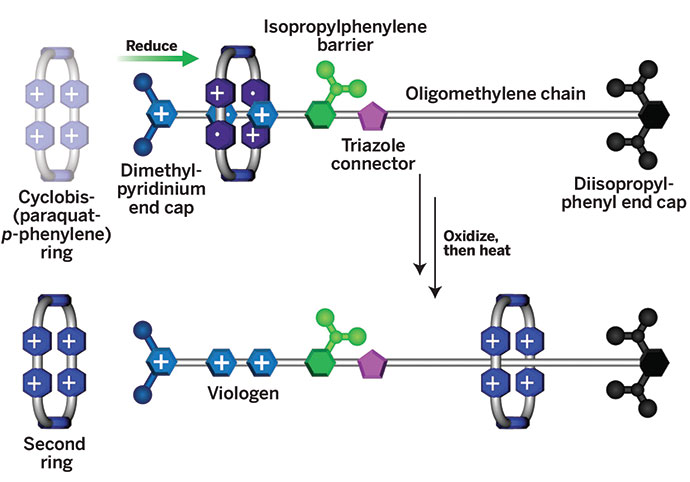Advertisement
Grab your lab coat. Let's get started
Welcome!
Welcome!
Create an account below to get 6 C&EN articles per month, receive newsletters and more - all free.
It seems this is your first time logging in online. Please enter the following information to continue.
As an ACS member you automatically get access to this site. All we need is few more details to create your reading experience.
Not you? Sign in with a different account.
Not you? Sign in with a different account.
ERROR 1
ERROR 1
ERROR 2
ERROR 2
ERROR 2
ERROR 2
ERROR 2
Password and Confirm password must match.
If you have an ACS member number, please enter it here so we can link this account to your membership. (optional)
ERROR 2
ACS values your privacy. By submitting your information, you are gaining access to C&EN and subscribing to our weekly newsletter. We use the information you provide to make your reading experience better, and we will never sell your data to third party members.
Synthesis
Supramolecular Extension Cord
Self-assembling photoinduced electron-transfer system mimics macroscopic device
by Michael Freemantle
November 29, 2006

The bottom-up construction of molecular computers has come one step nearer with the development of a solution-phase plug-and-socket molecular system that is an analog of a macroscopic electrical extension cord.
The "wet" self-assembled system has three molecular components: a light-powered electron source, an electron drain, and a connecting cable, one end of which connects to the source and the other to the drain. It was designed and constructed by chemistry professors Vincenzo Balzani of the University of Bologna, in Italy, and J. Fraser Stoddart of the University of California, Los Angeles, and their coworkers (Proc. Natl. Acad. Sci. USA 2006, 103, 18411).
“We carefully designed the system so that the connections between the three components are reversible,” Balzani tells C&EN. “The system can therefore be programmed to perform signal processing in solution.”
The light-harvesting component is a ruthenium bipyridyl complex connected to a dibenzocrown ether unit that acts as a socket. The cable has a dialkylammonium ion center that can plug into the socket by hydrogen bonding. At the other end of the cable is a  -electron rich benzonaphthocrown ether socket. The electron drain, a
-electron rich benzonaphthocrown ether socket. The electron drain, a  -electron acceptor bipyridinium unit, plugs into the cable’s socket by
-electron acceptor bipyridinium unit, plugs into the cable’s socket by  -electron donor-acceptor bonding.
-electron donor-acceptor bonding.
“In the fully assembled system, excitation with visible light of the electron power unit is followed by transfer of an electron, on the nanosecond timescale, through the extension cable to the electron drain,” Balzani explains.
The system is switched on and off by connecting and disconnecting the molecular components. Acid-base and redox stimuli are used as switches for the hydrogen-bonding and  -donor-acceptor connections, respectively. Because the photoinduced electron flow in the fully connected system responds to two chemical inputs operating in series, the system can play the role of a logic gate.
-donor-acceptor connections, respectively. Because the photoinduced electron flow in the fully connected system responds to two chemical inputs operating in series, the system can play the role of a logic gate.
This socket-plug-socket-plug system is an improvement on a similar system that the same team reported four years ago (C&EN, Oct. 21, 2002, page 17). That system did not mimic a real extension cord because it had a socket-plug-plug-socket configuration. In addition, the photoinduced electron transfer did not reach the last component of the assembly.
The new system is a more accurate molecular analog of the macroscopic device, comments A. Prasanna de Silva, a chemistry professor at Queen’s University, Belfast, Northern Ireland. The construction of molecular analogs of devices from the macro world is “a very profitable approach” to developing molecular nanosystems with demonstrable functions, he adds.
The work is a “beautiful” extension of the 2002 concept, according to Oxford University chemistry professor Harry L. Anderson. “One day, photoinduced electron transfer might be used in molecular-scale information-processing devices,” he says. “The work represents an interesting step in this direction by demonstrating how simple components can be designed so that they spontaneously self-assemble into complex functional architectures. In the future, it should be possible to construct a system like this one in which the ‘extension cord’ really behaves as a molecular wire, mediating long-range electron transport.”





Join the conversation
Contact the reporter
Submit a Letter to the Editor for publication
Engage with us on Twitter